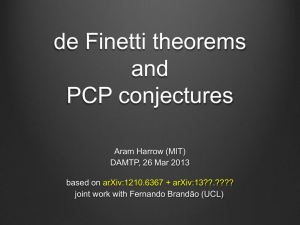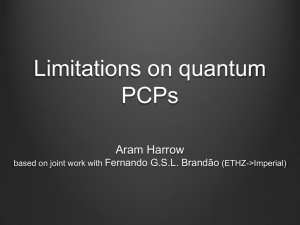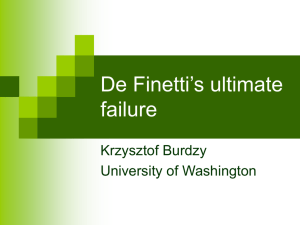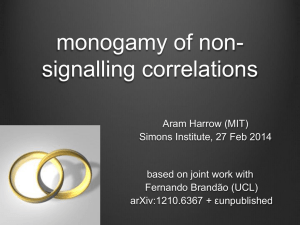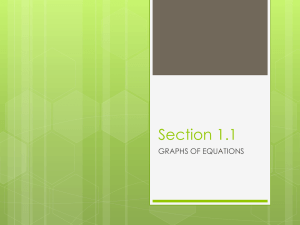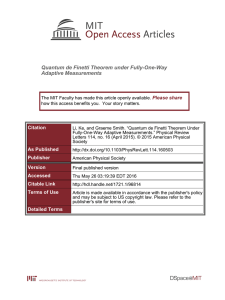Quantum de Finetti theorems under local measurements
advertisement
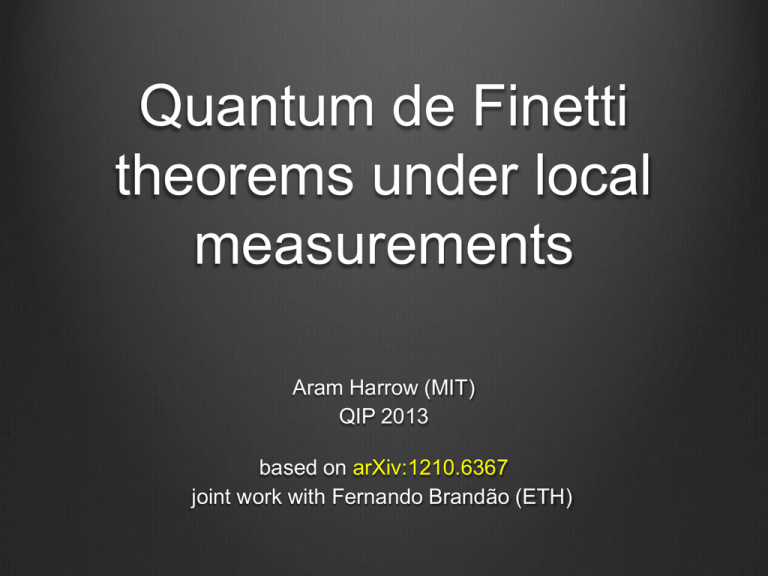
Quantum de Finetti
theorems under local
measurements
Aram Harrow (MIT)
QIP 2013
based on arXiv:1210.6367
joint work with Fernando Brandão (ETH)
Symmetric States
is permutation symmetric in the B subsystems
if for every permutation π,
…
A
B1 B2 Bn-1 B4
B3 Bn
=
…
A
B1 B2 B3 B4
Bn-1 Bn
Quantum de Finetti Theorem
Theorem [Christandl, Koenig, Mitchison, Renner ‘06]
Given a state
exists µ such that
symmetric under exchange of B1…Bn, there
builds on work by [Størmer ’69], [Hudson, Moody ’76], [Raggio, Werner ’89]
[Caves, Fuchs, Schack ‘01], [Koenig, Renner ‘05]
Proof idea:
Perform an informationally complete measurement of n-k B systems.
Applications:
information theory: tomography, QKD, hypothesis testing
algorithms: approximating separable states, mean-field theory
Quantum de Finetti Theorem as
Monogamy of Entanglement
Definition: ρAB is n-extendable if there exists an extension
with
for each i.
all quantum states (= 1-extendable)
2-extendable
100-extendable
separable =
∞-extendable
Algorithms: Can search/optimize over n-extendable states in time dO(n).
Question: How close are n-extendable states to separable states?
Quantum de Finetti theorem
Theorem [Christandl, Koenig, Mitchison, Renner ‘06]
Given a state
exists µ such that
symmetric under exchange of B1…Bn, there
Difficulty:
1. Parameters are, in many cases, too weak.
2. They are also essentially tight.
Way forward:
1. Change definitions (of error or i.i.d.)
2. Obtain better scaling
relaxed/improved versions
Two examples known:
1. Exponential de Finetti Theorem: [Renner ’07]
error term exp(-Ω(n-k)).
Target state convex combination of “almost i.i.d.” states.
2. measure error in 1-LOCC norm [Brandão, Christandl, Yard ’10]
For error ε and k=1, requires n ~ ε-2 log|A|.
This talk
improved de Finetti theorems for local
measurements
main idea
use information theory
log |A| ≥
I(A:B1…Bn) = I(A:B1) + I(A:B2|B1) + … + I(A:Bn|B1…Bn-1)
repeatedly uses chain rule: I(A:BC) = I(A:B) + I(A:C|B)
I(A:Bt|B1…Bt-1) ≤ log(|A|)/n for some t≤n.
If B1…Bn were classical, then we would have
≈separable
Question:
How to make B1…n
classical?
distribution
on B1…Bt-1
≈product state
(cf. Pinsker ineq.)
Answer: measure!
Fix a measurement M:BY.
I(A:Bt|B1…Bt-1) ≤ εfor the measured state (id ⊗ M⊗n)(ρ).
Then
• ρAB is hard to distinguish from σ∈Sep if we first apply (id⊗M)
• || (id⊗M)(ρ-σ)|| ≤ small for some σ∈Sep.
Theorem
Given a state
symmetric under exchange of B1…Bn, and {Λi}
a collection of operations from AX,
Cor: setting Λ=id recovers [Brandão, Christandl, Yard ’10] 1-LOCC result.
advantages/extensions
Theorem
Given a state
symmetric under exchange of B1…Bn, and {Λi}
a collection of operations from AX,
1.
2.
3.
4.
5.
6.
Simpler proof and better constants
Bound depends on |X| instead of |A| (can be ∞ dim)
Applies to general non-signalling distributions
There is a multipartite version (multiply error by k)
Efficient “rounding” (i.e. σ is explicit)
Symmetry isn’t required (see Fernando’s talk on Thursday)
applications
• nonlocal games
Adding symmetric provers “immunizes” against entanglement /
non-signalling boxes. (Caveat: needs uncorrelated questions.)
Conjectured improvement would yield NP-hardness for 4 players.
• BellQMA(poly) = QMA
Proves Chen-Drucker SAT∈BellQMAlog(n)(√n) protocol is optimal.
• pretty good tomography [Aaronson ’06]
on permutation-symmetric states (instead of product states)
• convergence of Lasserre hierarchy for polynomial optimization
see also 1205.4484 for connections to small-set expansion
open questions
• Is QMA(2) = QMA? Is SAT∈QMA√n(2)1,1/2 optimal?
(Would follow from replacing 1-LOCC with SEP-YES.)
• Can we reorder our quantifiers to obtain
(no-signalling analogue is FALSE assuming P≠NP)
• The usual de Finetti questions:
• better counter-examples
• how much does it help to add PPT constraints?
arXiv:1210.6367
